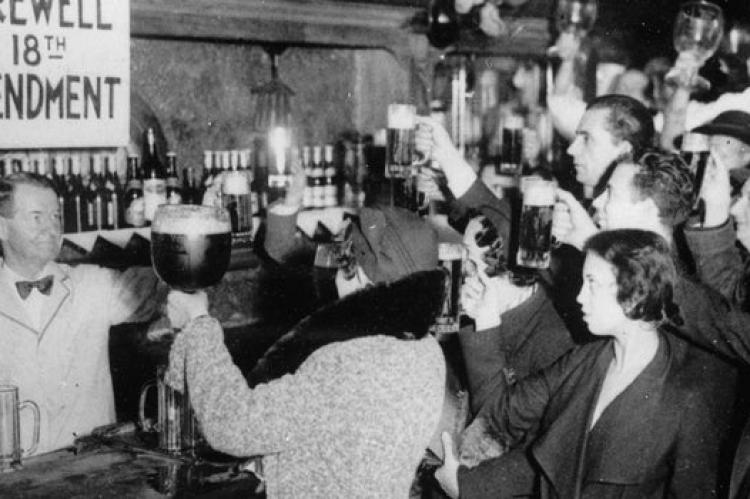What The Cannabis Industry Can Learn From Alcohol Post-Prohibition
In brand messaging, the end of the ban on booze and the start of modern cannabis legalization are singing similar tunes.
At this point in the national discourse, the end of cannabis prohibition is now seen as an inevitability instead of a possibility. Many have started to compare cannabis legalization to repeal of the 18th Amendment and the re-legalization of alcohol. But how similar are they really? The answer may surprise you.
First Of All, It's Not A Perfect Comparison
While there are many similarities in the two industries' post-prohibition history, one big difference has to do with the time period. While cannabis has been outlawed in the United States since the passage of the Marihuana Tax Act of 1937, alcohol was only illegal for a comparatively brief 14 years.
Before alcohol prohibition was passed, large-scale national alcohol companies already existed and continued to operate throughout the prohibition era by pivoting their business. The Pabst Brewing Company started making a processed cheese spread called Pabst-ett, Yuengling started making ice-cream, and Anheuser-Busch kept itself afloat by making soft drinks and nonalcoholic malt beverages.
In contrast, the cannabis industry did not exist in 1937; there was no infrastructure, no national brands. When alcohol prohibition was repealed, companies like Pabst could continue to produce alcohol like nothing ever happened. The same cannot be said of the cannabis industry, which is only starting to get past its infancy.
While it's difficult to make a perfect one-to-one comparison, but there are some striking similarities.
Both Alcohol And Cannabis Struggle With Advertising
Following the repeal of alcohol prohibition, one would think that beer and liquor companies would have been quick to flood the market with advertisements for their products. But they didn't. An article in the 1933 December edition of AdWeek noted that “while the 14-year-old Prohibition dyke broke with a loud 'pop,' ... national advertising placed by distillers, importers or national sales agencies was extremely scarce…”
Alcohol companies back then weren’t able to quickly capitalize on legal alcohol sales because of regulations, or the lack thereof. In Wisconsin, which was one of the most booze-friendly states at the time, the repeal of prohibition meant little to the state’s residents because the state legislature’s special alcohol session met late in the year.
While the floor eventually opened up for alcohol advertisers, the same cannot be said for cannabis. In most states where cannabis is legal, advertising is strictly regulated by state legislatures. While federal legalization is likely to make it easier to advertise cannabis, it is unlikely that the industry will enjoy the same marketing freedoms that alcohol companies enjoyed following the end of prohibition.
Alcohol Brands Once Asked The Same Questions That Cannabis Brands Are Asking Now
While the roll-out of cannabis legalization is not quite the same as the end of alcohol prohibition, when it comes to branding, the two seem almost identical. In November 1933, Fortune Magazine published an article that waxed philosophically about what (alcohol) legalization would mean for a new generation of drinkers.
The article goes on to ask eerily similar questions about how much would need to meet increasing demand, as well as the rise of newer, more sophisticated consumers. Like cannabis, this new subset of sophisticated alcohol consumers included a group that was previously excluded from most marketing decisions: women.
“Taste may have changed in another direction. Nobody knows how much the U.S. has grown up since there were iron deer on the lawns, but it has certainly become more sophisticated,” reads the articles. “And some optimists think that now that the sophisticated generation has asserted itself in a fourteen-year gin spree it will settle down to a mature appreciation of the finer qualities of alcohol.”
Sound familiar? Cannabis brands are waking up to the realization that consumer preferences are changing. People are now looking for a more sophisticated experience than just imbibing an intoxicating substance. Our industry today, like alcohol then, is grappling with how to appeal to new consumers.
While it may not be the perfect comparison, there are still some striking similarities between the end of alcohol prohibition and the crawl to cannabis legalization. Both industries were stymied by state legislatures that were slow to respond to changing circumstances, and both faced the challenge of how to sell to a new generation of consumers.
Unlike alcohol, however, the cannabis industry does not have decades worth of branding and well-funded research to fall back on. For this reason, cannabis entrepreneurs will have to forge their own destiny if they hope to become as prosperous.
- Log in to post comments

